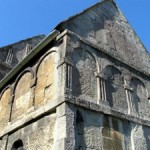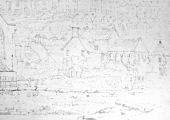.
St Laurence, The Saxon Church
Church Street, Bradford on Avon
.
.
Bradford on Avon’s Saxon Church is a well-preserved example of church-building from the period before the Norman Conquest. It is unusual in being entirely constructed of cut ashlar stone which has been carved externally with pilaster strips and blind arcading. The stone is very likely to be local, despite a legend about it coming from Hazelbury, in Box.
It has a nave and chancel and a porticus (porch-wing) on the northern side and the roof-line of another missing porticus on the southern side.
Dating the building has been controversial in the past, with some people wishing to make it St Aldhelm’s monastery church of the early 8th century, but it is now agreed that stylistically it belongs to the late 10th or early 11th century. It was probably erected around the time of the first millennium in 1001, at the same time as King Æthelred II gave his Manor of Bradford to the Abbey of Shaftesbury in Dorset. Æthelred made the gift so that Bradford could be a refuge for the nuns and for the bones of St Edward from the raids by the Danes and the building might have been intended to house the saint’s remains. If there had been a church founded by Aldhelm, its foundations are probably under the present Holy Trinity parish church.
The medieval historian William of Malmesbury noted that there was still in his day (in about 1125) a little church dedicated to the “Blessed Laurence” and he assumed it was part of a monastery that was reputed to have been founded in Bradford by St Aldhelm. It had long gone out of use and had been divided up and become embedded in later buildings when the antiquarian Vicar of Bradford, Canon William Henry Jones, noticed it in the 1850s and identified it with William’s little church. The building had, however, previously been sketched by another antiquarian, Rev William Collings Lukis, Curate of Bradford in 1847.
By the time of its “discovery” it had been used as a “skull house” or charnel house for storing bones that had been removed from Holy Trinity’s graveyard and in 1712 had become the Free Grammar School, with the master’s house in place of the south porticus, with a separate cottage occupying the chancel. Sheds and stable had been built against the southern wall and a drying house connected with an adjacent cloth workshop on the northern side.
A trust was set up which acquired the property in 1872. James Thomas Irvine, clerk-of-works to Sir George Gilbert Scott, studied the church while he was supervising work on Bath Abbey and was appointed to oversee restoration work in 1874. However, Irvine was replaced in 1881 by the Bradford architect Charles Septimus Adye whose work was controversial, involving demolition of the schoolmaster’s house and replacing it with huge unsightly butresses. The buttresses were replaced by less obtrusive ones in 1933 and they remain today. Irvine’s drawings are Bath City Library.
 The Saxon Church before restoration in the 1870s in a photograph on a postcard by R. Wilkinson. The building to the right was a cloth workshop attached to Abbey House and not to the church. A shed had already had its roof removed, but the master’s house was still in position on the left. A mark from the roof-line of a shed can still be seen on the wall of the church.
The Saxon Church before restoration in the 1870s in a photograph on a postcard by R. Wilkinson. The building to the right was a cloth workshop attached to Abbey House and not to the church. A shed had already had its roof removed, but the master’s house was still in position on the left. A mark from the roof-line of a shed can still be seen on the wall of the church.
.
.
.
.
.
.
..
.
.
.
.
.
.
.
.
 The interior of the church in 1885. The walls were shored up because of a fear that they might collapse after removal of floor joists on the recommendation of Ewan Christian (1814-1895, architect of the National Portrait Gallery in London). Some restoration had already been carried out as can be seen from new stonework around the door arch. In that year the Trustees recorded that the heavy stone tiles of the roof had been removed and it had been given a temporary felt covering to protect the structure. Also, they reported that funds had run out and appealed for more donations to finish the work.
The interior of the church in 1885. The walls were shored up because of a fear that they might collapse after removal of floor joists on the recommendation of Ewan Christian (1814-1895, architect of the National Portrait Gallery in London). Some restoration had already been carried out as can be seen from new stonework around the door arch. In that year the Trustees recorded that the heavy stone tiles of the roof had been removed and it had been given a temporary felt covering to protect the structure. Also, they reported that funds had run out and appealed for more donations to finish the work.
.
.
.
.
.
.








